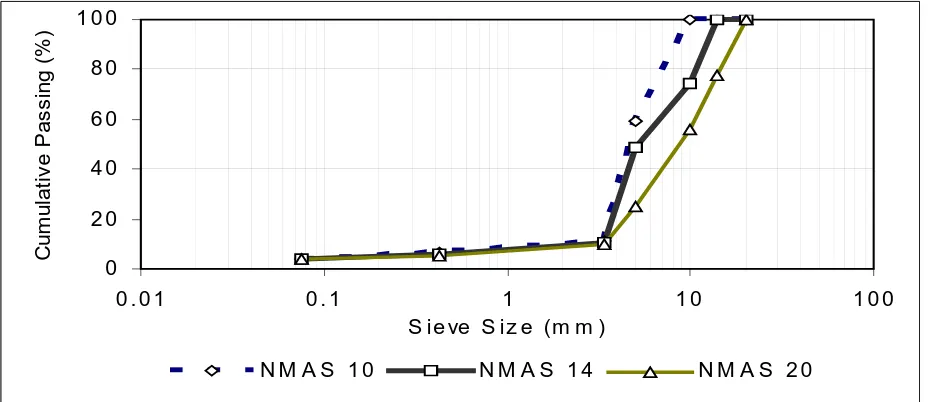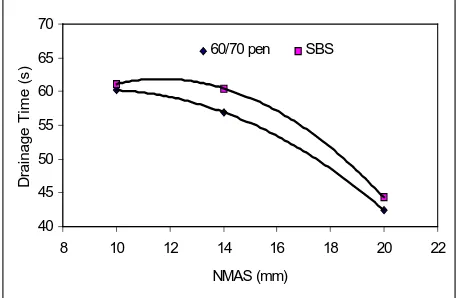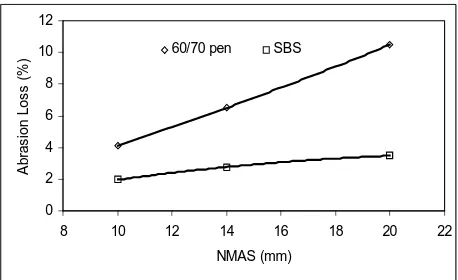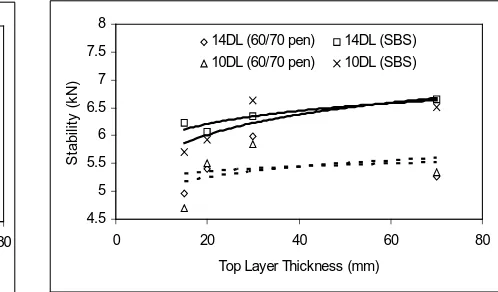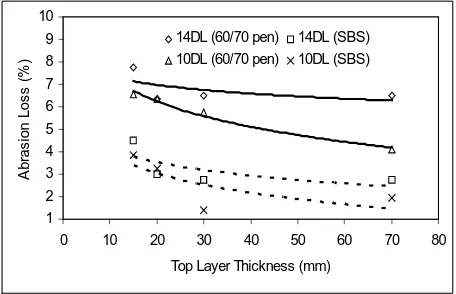The Comparison of Engineering Properties Between Single and
Double Layer Porous Asphalt made of Packing Gradation
Hardiman, M. Y.1
Abstract: This paper presents the comparison of engineering properties between single and double layer porous asphalt (SLPA and DLPA) made of packing gradation. Three nominal maximum aggregate sizes (NMAS) were tested each made up of 10, 14, and 20 mm for SLPA. While for the DLPA with 30, 20, and 15 mm top layer are made of 10 and 14 mm NMAS, with a base layer of 20 mm NMAS. Total thickness of all mixes is 70 mm. Binders used are 60/70 penetration base bitumen and polymer binder styrene-butadiene-styrene (SBS). The result shows that the properties of SLPA mix namely permeability and resistance to abrasion loss decreases when the NMAS in SLPA decreases. The abrasion loss of DLPA mixes increases when the porous asphalt top layer thickness decreases, while drainage time value decreases. However, SLPA with 20 mm NMAS exhibits higher abrasion loss compared to all DLPA mixes.
Keywords: double layer porous asphalt, single layer porous asphalt, engineering properties.
Introduction
Porous asphalt has been used extensively worldwide especially in European countries such as Spain, Switzerland, Belgium, Holland, the United King-dom, some states in the USA, Japan and Singapore [1]. Porous asphalt is normally used as a wearing course material and always laid on an impervious binder course. It is effective in enhancing traffic safety particularly during rainy weather as it reduces hydroplaning potential and has good skid resistance properties at high speed. The use of porous asphalt also reduces traffic noise and glare on wet surface. In addition, porous asphalt exhibits superior resistance against permanent deformation.
Although there are a number of proven advantages in porous asphalt applications, there are also problems that need to be handled in its applications. One of the problems affecting the service life of porous asphalt is permeability loss due to clogging, which are caused by clogging due to dust and consolidation of voids [2, 3, 4, 5].
According to Huber [5], air voids decreased 3% to 4%, about one-fifth of initial voids after construction, but permeability dropped sharply. Despite the loss in permeability and air voids, the mix continued to reduce noise. This condition was measured during the first 5 years of service life.
1, Civil Engineering Syiah Kuala University, Darussalam, Banda Aceh 23111, Indonesia
E-mail: [email protected]
Note: Discussion is expected before November, 1st 2008, and will be published in the “Civil Engineering Dimension” volume 11, number 1, March 2009.
Received 22 April 2008; revised 30 Mei 2008; accepted 18 June 2008.
In porous asphalt, the quantity and gradation of coarse aggregate determines void content, hence permeability. In general, porosity can be increased by increasing the proportion of the coarse mineral aggregate and reducing the amount of fine aggregate fraction [6].
The main objective of these investigations is to compare the engineering properties of single layer and double layer porous asphalt made of packing gradation. Three nominal maximum aggregate sizes (NMAS) were tested each made up of 10, 14, and 20 mm for single layer porous asphalt (SLPA). While for the double layer porous asphalt (DLPA) the NMAS were made of 10 and 14 mm for the top layers which are 30, 20, and 15 mm thick, with a base layer 20 mm NMAS. The total thickness of all mixes is 70 mm. All specimens were prepared at design binder content of 60/70 penetration base bitumen and styrene-butadiene-styrene (SBS).
Materials and Methodology
Materials
Crushed aggregates supplied by Kuad Quarry Sdn. Bhd. in Penang were used in this investigation. The aggregates were sieved into their respective size range or fractions. The aggregate gradations adopted were based on the theory of aggregate packing [7]. From this procedure, three gradations, shown in Figure 1 that differs in terms of maximum aggregate sizes were developed and tested. Each gradation incorporated two percent hydrated lime filler.
binder content used in this investigation was based on the Cantabrian and binder drainage tests. From these tests, the design binder contents corresponding to 10, 14, and 20 mm maximum aggregate size were 5.4%, 5.0%, 4.5% and 5.7%, 5.2%, 4.6% respectively for conventional and SBS binders [8].
Methodology
DLPA is made up of top and base layer. In principle, the preparation of 70 mm thick double layer porous Marshall specimen is similar with the preparation of Marshall specimen for conventional single layer porous asphalt. The amount of aggregate for top and base layers were calculated based on the Marshall density of single layer. Knowing the density and volume, the actual amount of mix required can be calculated.
In order to simplify the mix identification, the single layer porous asphalt was designated as SL. Numbers in front of SL indicate the NMAS. Double layer porous asphalt was designated as DL. Symbol D1, D2 and D3 after DL were designated to represent top layer thicknesses 30, 20 and 10 mm respectively. Numbers in front of DL indicate the NMAS. Specimen designation is summarized in Table 1.
Table 1. Mix designation of SLPA and DLPA mixes
NMAS (mm) Mix
Designation 20 14 10
Single Layer
PA (SL) 20SL 14SL 10SL
Top Layer Thickness (mm) Top/Base
(NMAS) 30 20 15
14/20 14DLD1 14DLD2 14DLD3
Double Layer PA (DL)
10/20 10DLD1 10DLD2 10DLD3
1) Material preparation
Aggregate and filler were batched in metal con-tainer. An amount of 1100 g aggregate would suffice to cast one specimen. The batched aggregates were placed in an oven at the desired mixing temperature for a period of at least four hours. The base bitumen 60/70 and SBS binders respectively required at least two and four hours of pre-heating. The cycle of heating of each binder was kept consistent. The mixing and compaction temperatures for mixes prepared using the two types of binders are outlined in Table 2.
Table 2. Mixing and compaction temperatures
Temperature (ºC ) Binder Types
Mixing Compaction
60/70 Pen. Base Bitumen 140 130
SBS 180 160
2) Mixing
The mixing process started with firstly feeding the hot aggregates into the mixer and then mixed dry for one minute. This step ensured uniformity and homogeneity of the aggregate blend. The correct quantity of bitumen was then added into the blended aggregates and mixing continued. The mixing pro-cess ceased as soon as all aggregates was thoroughly coated with bitumen which normally required less than one minute of mixing time. Once the tempe-rature of the unsegregated mix had dropped unifor-mly to the required compaction temperature, approximately 1100 g of the material was trans-ferred into the hot mould. Using a metallic rod, the sample was tamped 15 times around the circum-ference and five times in the centre to ensure uniformity of mix. Next, the SLPA specimens were ready for full compaction at 2x50 blows.
0 2 0 4 0 6 0 8 0 1 0 0
0 . 0 1 0 . 1 1 1 0 1 0 0
S ie ve S iz e (m m )
C
u
m
u
la
ti
ve
P
a
ss
in
g
(
%
)
N M A S 1 0 N M A S 1 4 N M A S 2 0
3) Compaction procedure for DLPA specimen
The values of Marshall stability and permeability of DLPA compacted using two or three steps did not differ significantly [9]. Based on this reason, in this investigation, compaction was carried out in two steps at 2x50 blows.
4) Tests for porous asphalt at design binder content (DBC)
There are a number of tests for porous asphalt at DBC such as: permeability, Marshall stability, and abrasion loss.
Results and Discussion
Properties of SLPA mixes
1) Permeability
One of the expected benefits of porous asphalt mixes are its capability to allow water to drain vertically at the wearing course of the asphalt pavement and to flow horizontally above the impermeable course. The permeability of SLPA mixes is in units of second. The lower drainage time shows the better permeability. The complete results of permeability test on SLPA mixes are shown in Figure 2.
Fig. 2. Relationship between drainage time and NMAS of SLPA mixes
a) Effect of NMAS on drainage time
Figure 2 shows that the drainage time of SLPA mixes increase when a smaller size aggregate is used. The increase in drainage time of porous asphalt made of nominal maximum aggregate size 10 mm is about 26.5% when compared to mixes made of nominal maximum aggregate size of 20 mm and 5.1% to nominal maximum aggregate size 14 mm. This situation can be identified when coarse aggregate is used in SLPA mixes and it increases the porosity value. The high value of porosity also leads to a high permeability.
b) Effect of binder type on drainage time
Based on the result shown in Figure 2, the drainage time of SBS mixes is higher compared to base bitumen mixes. Drainage time of SBS mixes are on average 10.0% higher than base bitumen mixes. The increase in nominal maximum aggregate size and the decrease in DBC may increase the voids in mix. Higher voids generally lead to higher permeability which is an important property of porous asphalt. However, this must be traded-off with specimen strength and durability.
2) Marshall stability
The Marshall stability results are shown in Figure 3. The stability of SLPA mixes made of SBS is higher than those prepared using base bitumen.
4
Fig. 3. Relationship between stability and NMAS of SLPA mixes
a) Effect of NMAS on stability
The dominant role of coarse aggregate in porous asphalt mixes was discussed earlier. Based on this, the coarse aggregate in porous asphalt is expected to give an interlocking effect between coarse aggregate, so that it can contribute to the strengths and also an increase in mix porosity. However, this mix is not durable because mix that use open graded mix is exposed to oxidation and as a result, aggregate is easily separated from each other. The effect of coarse aggregate in porous asphalt mixes, whether it is made of SBS or conventional asphalt are visualized in Figure 3. Result of the investigation shows that the Marshall stability of single layer porous asphalt mixes tends to decline when a coarser aggregate is used. However, the Marshall stability obtained is higher than the allowable minimum requirement which is 5 kN.
b) Effect of binder type on Marshall stability
investiga-tions have proved that porous asphalt made of modified asphalt could improve mix properties, Marshall stability value is one of them. Result of investigation shows that the average increase in Marshall stability of single layer porous asphalt mixes using SBS is 18.3% compared to base bitumen.
3) Voids in mix (VIM)
Voids in SLPA mixes made of SBS and base bitumen are shown in Figure 4.
Fig. 4. Relationship between VIM and NMAS of SLPA
mixes
a) Effect of NMAS on VIM
As explained earlier, coarse aggregate in porous asphalt mixes played a vital role on volumetric properties especially void in mix (VIM). This VIM is much related to other mix properties such as permeability capacity and durability of asphalt mix. When a bigger void in mix (VIM) value is needed, the combination should be based on coarser nominal maximum aggregate size and the smaller proportion of fine aggregate. A clearer effect of coarse nominal maximum aggregate size in porous asphalt mixes are shown in Figure 4.
Further, the effect of nominal maximum aggregate sizes on VIM of porous asphalt mixes are shown in Figure 4. The results show that the increase in VIM of porous asphalt mixes is lower when a coarser aggregate is used. A coarser aggregate can produce a more opened mix structure. This earlier explanation on VIM value is a property which plays a significant role in porous asphalt mixes properties, especially in the case of permeability and durability capacity. A high permeability is highly expected in porous asphalt mixes. A high permeability can only be gained at a higher VIM. The high value of VIM gives an impact which is less favorable on durability. So, the VIM needed in porous asphalt mixes should fulfill two criterion, permeability and durability.
Result of investigation shows that VIM in porous asphalt mixes can meet the requirement of VIM design which is above 20%.
b) Effect of binder type on VIM
Based on results shown in Figure 4, it can be seen that porous asphalt mixes that are using SBS modified binder has a lower VIM than the base bitumen. VIM decreases at the average of 1.0% when it is compared to SLPA mix using base bitumen.
4) Resistance to disintegration
The resistance to disintegration of SLPA mixes is evaluated in terms of its abrasion loss and the results are shown in Figure 5.
0
Fig. 5. Relationship between abrasion loss and NMAS of SLPA mixes
a) Effect of NMAS on resistance to disintegration
As explained earlier in the literature review, the resistance to disintegration of single layer porous asphalt mixes to a great extent was related to the porosity factor. The open structure of porous asphalt mix enables oxygen to enter asphalt mix easily. The reaction with oxygen is a reason that causes asphalt to become brittle and coarse aggregate can be easily removed from the mix. Resistance to disintegration can be distinguished from the Cantabrian test. Resistance to disintegration increases when the value of abrasion loss decreases. The effect of nominal maximum aggregate size on resistance to disintegration of SLPA mixes are shown in Figure 5. Research result shows that the resistance to disintegration of SLPA mixes is better when finer aggregate is used. For instance, the resistance to disintegration of porous asphalt made of NMAS 10 mm increases by 56.5% compared to NMAS 20 mm and 34.5% to NMAS 14 mm.
b) Effect of binder type on resistance to disinte-gration
compared to base bitumen mixes. Incorporation of SBS in a porous mix can cause the resistance to disintegration to increase by an average of 58.8% when compared to the base bitumen mixes. This may be attributed to the more superior inter-particle adhesion of such mixes. Other factors that appear to influence the resistance to disintegration include nominal maximum aggregate size, design binder content and binder type. An improvement in resis-tance to disintegration is noticeable by increasing the binder content and decreasing the nominal maxi-mum aggregate size. For 20 mm nominal maximaxi-mum aggregate size mixes, the DBC is lower but the porosity is higher. This probably explains the cause for its lower abrasion resistance.
Properties of DLPA mixes
1) Permeability
The research result on permeability of DLPA mixes, for both mixes using top layer of nominal maximum aggregate size 14 mm and 10 mm are shown in Figure 6.
Top Layer Thickness (mm)
D
14DL (60/70 pen) 14DL (SBS) 10DL (60/70 pen) 10DL (SBS)
Fig. 6. Relationship between drainage time and top layer thickness
a) Effect of NMAS and thickness of top layer on drainage time
There are three types of nominal maximum aggregate size used in double layer porous asphalt mixes, NMAS 14 mm and NMAS 10 mm as the top layer, while NMAS of 20 mm as the base layer. The complete result of permeability test is shown in Figure 6. The result shows that the drainage time values for all mixes tend to increase when the thickness of top layer increases. Meanwhile, the top layer using coarser aggregate mix (NMAS 14 mm) also shows a lower drainage time value compared to the top layer using NMAS 10 mm.
This signifies that the drainage time of DLPA mixes gained is greatly influenced by thickness and nominal maximum aggregate sizes of the top layer.
From the permeability results, it is revealed that the top layer of DLPA mixes can function as a filter which control water flow vertically to base layer. However, the lowest drainage time is 48.2 seconds is measured for mix made of 15 mm top layer thickness and 10 mm nominal maximum aggregate size. The reduction of drainage time shows that the permea-bility of porous asphalt mixes is improved.
b) Effect of binder type on drainage time
Based on research findings demonstrated in Figure 6, the drainage time of SBS mixes is higher com-pared to base bitumen mixes. Drainage time of SBS mixes are on the average of 7.1% and 8.0% higher than base bitumen mixes respectively for top layer made of nominal maximum aggregate sizes 14 and 10 mm.
2) Marshall stability
The situation is the same for SLPA mixes where the DLPA mixes were tested by using Marshall test equipment and the result is shown in Figure 7.
4.5
Top Layer Thickness (mm)
S
14DL (60/70 pen) 14DL (SBS) 10DL (60/70 pen) 10DL (SBS)
Fig. 7. Relationship between stability and top layer thick-ness
a) Effect of NMAS and thickness of top layer on Marshall stability
respectively. All mixes of double layer can fulfill the minimum requirement for stability which is 5 kN.
b) Effect of binder type on Marshall stability
Based on results shown in Figure 7, the stability of DLPA mixes made of SBS is higher than those prepared using base bitumen. The increase in Marshal stability of DLPA by using SBS and NMAS 14 and 10 mm is at the average of 14.57% and 14.13% when compared to base bitumen. However, mixes prepared using 10 mm NMAS, SBS and 30 mm top layer thickness record the highest stability. All mixes incorporating SBS and 14 mm top layer NMAS results in stability above 6.0 kN.
3) Resistance to disintegration
The resistance to disintegration of DLPA mixes is evaluated in terms of its abrasion loss and the results are shown in Figure 8.
Top Layer Thickness (mm)
A
14DL (60/70 pen) 14DL (SBS)
10DL (60/70 pen) 10DL (SBS)
Fig. 8. Relationship between abrasion loss and top layer
thickness
a) Effect of NMAS and thickness of top layer on resistance to disintegration
One of the weaknesses of porous asphalt application in field is its poor mix durability. The proportion of coarse aggregate that is more dominant than fine aggregate and the bigger NMAS in porous asphalt mixes create a more open aggregate gradation structure. An open gradation of porous asphalt allows oxygen to penetrate the mix. The reaction that happens between oxygen and binder creates a brittle mix. When the abrasion loss is higher, the resistance to disintegration of porous asphalt mixes is low. Figure 8 shows that the abrasion loss increases when the nominal maximum aggregate size of top layer is bigger and this value decreases when the thickness of top layer increases. This indicates that the increase in thickness of top double layer can improve the resistance to mix disin-tegration. The result obtained is suitable with the Cantabrian test result for single layer porous asphalt
mixes where the resistance to disintegration decre-ases when coarser aggregate used. The bigger nominal maximum aggregate size that was used in base layer compared to top layer had influenced the abrasion loss value. This condition can be understood as the base layer is a low stable mix because this layer has a high voids in mix. Covering the surface of base layer with a finer top layer can increase the durability of double layer porous asphalt mixes. However, the test result shows that the double layer porous asphalt mixes made of top layer with NMAS 10 mm is better than NMAS 14 mm.
b) Effect of binder type on resistance to disintegra-tion
Based on the result shown in Figure 8, SBS mixes are found to be more resistant to disintegration compared to base bitumen mixes. Incorporation of SBS in a porous mix can cause the resistance to disintegration to increase by an average of 51.1% and 55.3% when compared to the base bitumen mixes respectively for top layer made of NMAS 14 and 10 mm. This may be attributed to a more superior inter-particle adhesion of such mixes. However, mixes prepared using 10 mm NMAS, SBS and 30 mm top layer thickness record the highest resistance to disintegration. The abrasion loss of all mixes prepared using SBS and base bitumen respectively experienced 1.4% to 4.5% and 5.7% to 7.8%. An improvement in resistance to disinte-gration is noticeable by increasing the binder content and decreasing the nominal maximum aggregate size. For instance, the resistance to disintegration increases by up to 75.9% when porous asphalt are made of SBS and compared to base bitumen at top thickness layer 30 mm.
Conclusions
1) The properties of porous asphalt are influenced by NMAS and binder type. The important properties of SLPA such as VIM, Abrasion Loss, and permeability increase when a coarser NMAS is used. When using SBS, Marshall stability, resistance to disintegration are also increased. The use of SBS in SLPA can improve Marshall stability by 18.3%, resistance to disintegration by 58.8%. However, resistance to disintegration of porous asphalt made of NMAS 10 mm increases by 56.5% compared to NMAS 20 mm and 34.5% to NMAS 14 mm.
size 14 and 10 mm is at the average of 14.57% and 14.13%, respectively when compared to base bitumen.
3) The increase in drainage time of DLPA is greater than SLPA made of NMAS 20, 14 and 10 mm. Overall, the best permeability is SLPA made of NMAS 20 mm because the drainage time of SLPA NMAS 20 mm is the lowest when using for both binders. However, drainage time of SBS mixes are on the average of 7.1% and 8.0% higher than base bitumen mixes respectively for top layer made of nominal maximum aggregate sizes 14 and 10 mm.
4) Resistance to disintegration in DLPA mixes are lower compared to SLPA mixes made of NMAS 14 and 10 mm, but the resistance to disintegration of DLPA mix is much better than SLPA mix with NMAS 20 mm. Incorporation of SBS in a porous mix can cause the resistance to disintegration to increase by an average of 51.1% and 55.3% when compared to the base bitumen mixes respectively for top layer made of NMAS 14 and 10 mm.
Acknowledgements
The data used in this paper was based on a research project on porous asphalt, which was funded by the IRPA Grant, the Ministry of Science, Technology and Innovation, Malaysia. Thanks are also extended to the University of Science Malaysia for its facilities and Associate Professor Dr. Meor Othman Hamzah as the Project Leader
References
1. Hwee, L.B. and Guwe, V., Performance Related Evaluation of Porous Asphalt Mix Design, Procee-ding of Malaysian Road Conference, Kuala Lumpur, Malaysia, 2004.
2. Bochove, V.G.G., Twinlay, A New Concept of Drainage Asphalt Concrete, 1st Eurasphalt and Eurobitume Congress, Strasbourg, 1996.
3. Nakanishi, H., Takei, S., and Goto, K., Sugges-tion to the Improvement in Durability of the Function of Porous Asphalt Pavements, Road Construction, Japan (English Version), August 1995.
4. Fwa, T.F., Tan, S.A., and Guwe, Y.K., Laboratory Evaluation of Clogging Potential of Porous Asphalt Mixtures, Journal of the Transportation Research Board (TRB),No. 1681, 1999, pp, 43-49.
5. Huber, G., Performance Survey on Open-graded Friction Course Mixes, National Co-Operative Highway Research Program, Synthesis of High-way Practice 284, Transportation Research Board, National Academy Press, Washington DC, USA, 2000.
6. Cabrera, J.G. and Hamzah, M.O., Aggregate Grading Design for Porous Asphalt, E&FN Spon, London, UK, 1996, pp, 10-22.
7. Hardiman, M.Y., Application of Packing Theory on Grading Design for Porous Asphalt Mixtures,
Dimensi Teknik Sipil (Civil Engineering Dimen-sion), Volume 6, No. 2, September 2004, pp, 57-63.
8. Hamzah, M.O. and Hardiman, M.Y., Effect of Maximum Aggregate Size on Single Layer Porous Asphalt Properties and a Proposal for Double Layer to Resist Clogging, Proceedings of the 6th Malaysian Road Conference, Malaysia,
2004.
